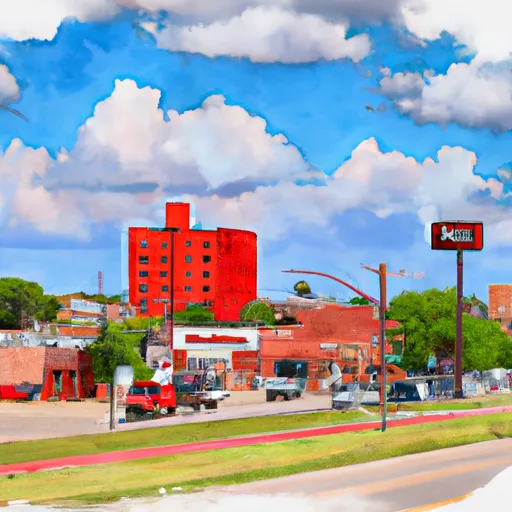-
 Snoflo Premium
Snoflo Premium
Get unlimited access to all our content
With no Ad interruptions! - Start Your Free Trial Login with existing account
Hobart
Eden Index
Climate
10.0
•
Recreation
1.4
•
Community
1.8
•
Safeguard
4.9/10

Hobart, Oklahoma is a small town located in southwestern Oklahoma. It lies within the Great Plains region, characterized by a semi-arid climate. Summers are hot and dry, with temperatures often reaching into the high 90s (Fahrenheit), while winters are generally mild with occasional cold spells. The area experiences low to moderate rainfall, averaging around 25 inches per year.
The hydrology of Hobart is influenced by the Washita River, which flows just south of the town. This provides opportunities for outdoor activities such as fishing and boating. The river is known for its diverse fish population, including bass, catfish, and crappie, attracting anglers from the region.
In addition to the Washita River, Hobart is surrounded by picturesque landscapes and vast plains, making it an ideal location for activities like hiking, bird-watching, and photography. The nearby Quartz Mountain Nature Park offers various recreational opportunities, including camping, rock climbing, and wildlife observation.
Overall, Hobart's climate, hydrology, and outdoor recreation opportunities make it a charming destination for nature enthusiasts seeking to explore the beauty of the Great Plains region.
What is the Eden Index?
The Snoflo Eden Index serves as a comprehensive rating system for regions, evaluating their desirability through a holistic assessment of climate health, outdoor recreation opportunities, and natural disaster risk, acknowledging the profound impact of these factors on livability and well-being.
Climate Health Indicator (CHI): 10.0
Hobart receives approximately
706mm of rain per year,
with humidity levels near 61%
and air temperatures averaging around
16°C.
Hobart has a plant hardyness factor of
7, meaning
plants and agriculture in this region tend to thrive during the non-winter months.
By considering the ideal temperature range, reliable water supplies, clean air, and stable seasonal rain or snowpacks, the Climate Health Indicator (CHI) underscores the significance of a healthy climate as the foundation for quality living.
A healthy climate is paramount for ensuring a high quality of life and livability in a region, fostering both physical well-being and environmental harmony. This can be characterized by ideal temperatures, reliable access to water supplies, clean air, and consistent seasonal rain or snowpacks.
Weather Forecast
Streamflow Conditions
North Fork Red
Area Rivers
North Fork Red
Snowpack Depths
North Fork Red
Reservoir Storage Capacity
North Fork Red
Groundwater Levels
Recreational Opportunity Index (ROI): 1.4
The Recreational Opportunity Index (ROI) recognizes the value of outdoor recreational options, such as parks, hiking trails, camping sites, and fishing spots, while acknowledging that climate plays a pivotal role in ensuring the comfort and consistency of these experiences.
Access to outdoor recreational opportunities, encompassing activities such as parks, hiking, camping, and fishing, is crucial for overall well-being, and the climate plays a pivotal role in enabling and enhancing these experiences, ensuring that individuals can engage in nature-based activities comfortably and consistently.
Camping Areas
| Campground | Campsites | Reservations | Toilets | Showers | Elevation |
|---|---|---|---|---|---|
| Lake Frederick Park | 150 | 1,217 ft | |||
| Altus AFB Military | None | 1,355 ft | |||
| Great Plains State Park | None | 1,424 ft | |||
| Cordell Park | None | 1,530 ft | |||
| Hobart Lions Club RV Park | 8 | 1,546 ft | |||
| Foss State Park | None | 1,705 ft |
Nearby Fishing
Nearby Ski Areas
Catastrophe Safeguard Index (CSI):
The Catastrophe Safeguard Index (CSI) recognizes that natural disaster risk, encompassing floods, fires, hurricanes, and tornadoes, can drastically affect safety and the overall appeal of an area.
The level of natural disaster risk in a region significantly affects safety and the overall livability, with climate change amplifying these risks by potentially increasing the frequency and intensity of events like floods, fires, hurricanes, and tornadoes, thereby posing substantial challenges to community resilience and well-being.
Community Resilience Indicator (CRI): 1.8
The Community Resilience Indicator (CRI) recognizes that education, healthcare, and socioeconomics are crucial to the well-being of a region. The CRI acknowledges the profound impact of these elements on residents' overall quality of life. By evaluating educational resources, healthcare accessibility, and economic inclusivity, the index captures the essential aspects that contribute to a thriving community, fostering resident satisfaction, equity, and social cohesion.

